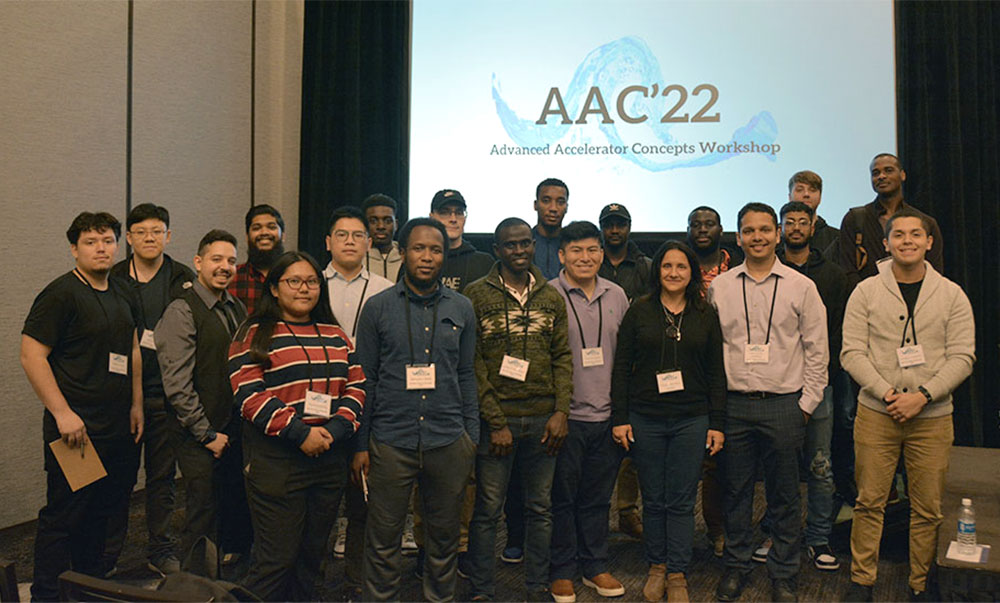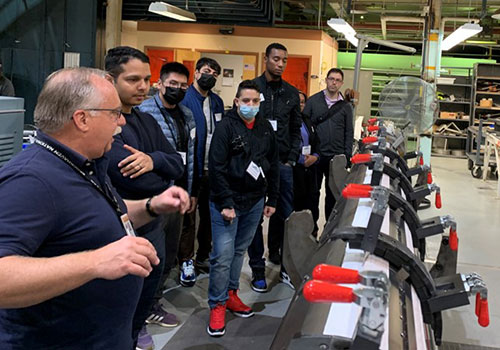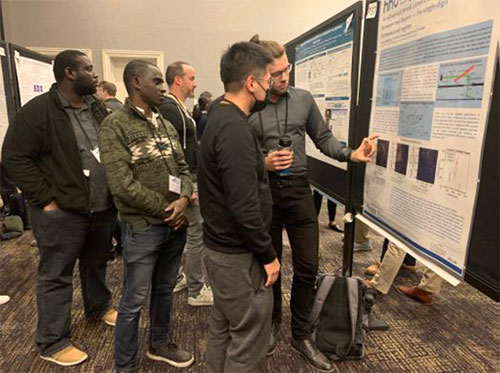City Tech Students, Faculty Join Brookhaven Lab at 20th Advanced Accelerator Concepts Workshop
NYCCT students get an in-depth look at accelerator science through lectures, workshops, and an on-site laboratory tour
December 29, 2022
 enlarge
enlarge
City Tech's Viviana Vladutescu and her students attending the 2022 Advanced Accelerator Concepts (AAC) Workshop
In early November 2022, the Advanced Accelerator Concepts (ACC) Workshop, sponsored by the Institute of Electrical and Electronics Engineers (IEEE) Council on Superconductivity, resumed its biennial forum after a four-year, COVID-related hiatus. Experts from around the country travelled to Hauppauge, NY, to discuss research in advanced accelerator physics and technology as well as the application and impact of that work.
While it’s important for professionals in the field to exchange ideas and ensure they are up to date with the latest advancements, the workshop also represents a great opportunity to spark students’ interest and engage university faculty. Alongside the workshops, networking events, and talks, the conference offered a tour of the Accelerator Test Facility (ATF), Relativistic Heavy Ion Collider, National Synchrotron Light Source II, and Superconducting Magnet Division at the U.S. Department of Energy’s (DOE) Brookhaven National Laboratory. A program like this allows students to see the subject matter they are exposed to in a real-world setting and truly get a feel for what it’s like to work in an accelerator facility.
ATF Director Mark Palmer, one of the workshop chairs, wanted to ensure attendance by a representative from the New York City College of Technology (NYCCT). He reached out to Viviana Vladutescu, associate professor of Electrical and Telecommunications Engineering, who eagerly accepted the invitation.
“As I started making arrangements, I felt like something was missing,” recalled Vladutescu, “I realized that it would be very selfish of me to take advantage of such an opportunity without my dear students. Dr. Palmer went above and beyond to find funds for us through ATF and the Lab’s Office of Diversity, Equity, and Inclusion (DEI) to make that happen. After several emails, phone calls, and texts, 20 of my students were registered for one of the most prestigious annual conferences on classical and wakefield accelerators, lasers, simulations, and related concepts.”
“An important part of our mission at the ATF is to enable a diverse community of students to gain hands-on experience with the particle accelerator and laser research,” said Palmer. “Our ongoing connection with Professor Vladutescu and NYCCT students is an important part of that. Helping the students participate in AAC was a great way to expose them to cutting-edge research from around the world and to encourage them to join us in these efforts.”
DOE support helped to keep costs manageable for students participating in the conference. Brookhaven National Laboratory covered the remaining student registration and accommodation costs for the students from NYCCT. One of the Laboratory’s key goals is to promote equity to ensure that historically underrepresented or underserved people have the opportunity to grow, contribute, and develop. NYCCT is a federally designated Hispanic-Serving Institution (HSI) and is committed to providing broad access to high quality technological and professional education for a diverse urban population.
“These types of collaborative efforts are spun from the development of meaningful and durable relationships with Minority Serving Institutions (MSIs), like NYCCT,” explained Noel Blackburn, Chief DEI Officer at Brookhaven Lab. “We are in the process of documenting our relations in a Memorandum of Understanding, which we hope to complete in the near future.”
Students got a big picture overview of what goes into building, operating, and maintaining accelerators and ultrafast, high-powered lasers. They learned about the safety precautions, financial considerations, and managerial responsibilities that occur behind the scenes alongside the more scientific and technical work that keeps everything running smoothly. Students also had time to network with scientists and other students as they explored future careers and graduate programs.
“I enjoyed seeing how these fields emphasize collaboration and teamwork to achieve their goals,” said NYCCT student Daniel Shaw. “I learned what a plasma wakefield accelerator is and what kind of experiments scientists conduct with them. Mark Hogan, from the Facility for Advanced Accelerator Experimental Tests (FACET-II), explained how they use their two-mile-long accelerator to compress ultra-high brightness beams generated from plasma injectors. This was something I enjoyed because it started to bridge the gap between what I see on TV and in the movies and what it actually takes to make these things possible.”
Meeting seasoned scientists one-on-one and touring a national laboratory touched upon a lot more than accelerator science. Students were able to see some of the universal practices and common skills that are widely applicable to all STEM fields, and to see them through the lens of their own educational journey.
“This conference showed me the importance of coding and its various impacts throughout engineering research,” said NYCCT student Timofey Serjanov. “This encouraged me to look into learning different coding languages, as this skill seems essential for high level scientific and technical work.”
“Students were able to get a clearer understanding of how important expertise, demeanor, and confidence are in public speaking,” said Vladutescu. “They were able to learn by example while connecting with colleagues outside of the classroom and forming long lasting relationships.”
The response from the students in attendance was overwhelmingly positive. It sparked interests, inspired plans for the future, and brought students and experts together in a way that doesn’t get to happen often.
“If more opportunities like this come up in the future, I would be interested in going again,” said Serjanov. “Some of the presentations were interesting and were accessible for undergraduate students like me. I would also be interested in visiting other labs during my time here at City Tech.”
These opportunities are important for both students and the professionals that are connecting with them. The goal isn’t to push students towards a particular area of research, but to encourage them to pursue their own unique STEM interests and make them accessible. Igniting these passions in students from all academic institutions helps to usher in an enthusiastic new generation of scientists, engineers, and technical professionals.
“While attending this conference, all I could think about is what I want to do with my career and how I’m going to achieve it,” said Shaw. “Being around people who are passionate about their craft was inspiring. Even though I don’t necessarily see myself going into the field of advanced accelerators, this experience pushed me in the right direction.”
Brookhaven National Laboratory is supported by the Office of Science of the U.S. Department of Energy. The Office of Science is the single largest supporter of basic research in the physical sciences in the United States and is working to address some of the most pressing challenges of our time. For more information, please visit science.energy.gov.
Follow @BrookhavenLab on Twitter or find us on Facebook.
2022-20936 | INT/EXT | Newsroom











